Tropical Smoothie Recipes: 15 Refreshing Ways to Bring Paradise to Your Blender
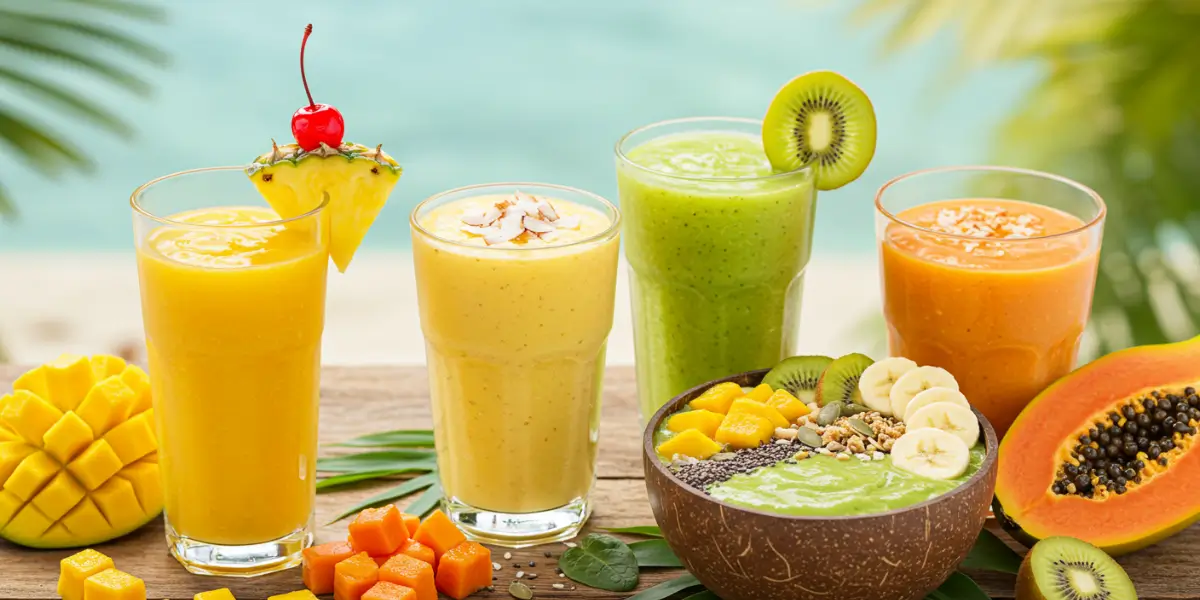
Have you ever closed your eyes while sipping a perfectly blended tropical smoothie and felt instantly transported to a sun-soaked beach? There’s something magical about the way tropical fruits combine—sweet, tangy, and refreshing all at once—creating that vacation-in-a-glass feeling even on the most ordinary days. As someone who spent three years experimenting with smoothie recipes during my work-from-home phase, I discovered that tropical smoothies aren’t just delicious treats; they’re portable nutrition powerhouses that can transform your daily routine.
Whether you’re craving a taste of the tropics on a dreary morning or looking for a nutritious post-workout refreshment, these tropical smoothie recipes offer the perfect escape. With vibrant ingredients packed with vitamins, minerals, and natural energy, these blends do more than just satisfy your taste buds—they nourish your body and brighten your day. Let’s dive into the world of tropical smoothies and discover how easily you can bring paradise to your kitchen.
The Essential Guide to Tropical Smoothie Ingredients
Creating the perfect tropical smoothie starts with understanding which ingredients will give you that authentic island flavor while delivering maximum nutritional benefits. The right combination of fruits, liquids, and add-ins makes all the difference between an ordinary drink and an extraordinary tropical experience.
Core Tropical Fruits for Authentic Flavor
The foundation of any tropical smoothie lies in its fruit selection. These fruits aren’t just flavorful—they’re nutritional powerhouses:
- Mango: Rich in vitamin C and vitamin A, mangoes add a velvety sweetness that forms the perfect base for tropical blends. Fresh mangoes offer superior flavor, but frozen chunks work wonderfully for convenience and creating a thicker texture.
- Pineapple: This quintessential tropical fruit provides bromelain, an enzyme that aids digestion, along with a perfect balance of sweetness and acidity. Always use the ripest pineapple for maximum sweetness—look for one that yields slightly to pressure and has a fragrant aroma at the base.
- Banana: Beyond adding natural creaminess and sweetness, bananas provide potassium and help create that smooth, milkshake-like consistency without adding dairy. For tropical smoothies, slightly overripe bananas with some brown spots will blend more easily and offer more natural sweetness.
- Papaya: Often overlooked but truly exceptional in smoothies, papaya contributes a subtle sweetness while providing digestive enzymes and vitamin C. Remove the seeds before blending, as they have a peppery flavor that can overpower your smoothie.
- Coconut: Whether you use coconut water, coconut milk, or coconut meat, this ingredient adds authentic tropical flavor and healthy fats. Fresh coconut meat provides the most authentic flavor, but unsweetened coconut flakes can be a convenient alternative.
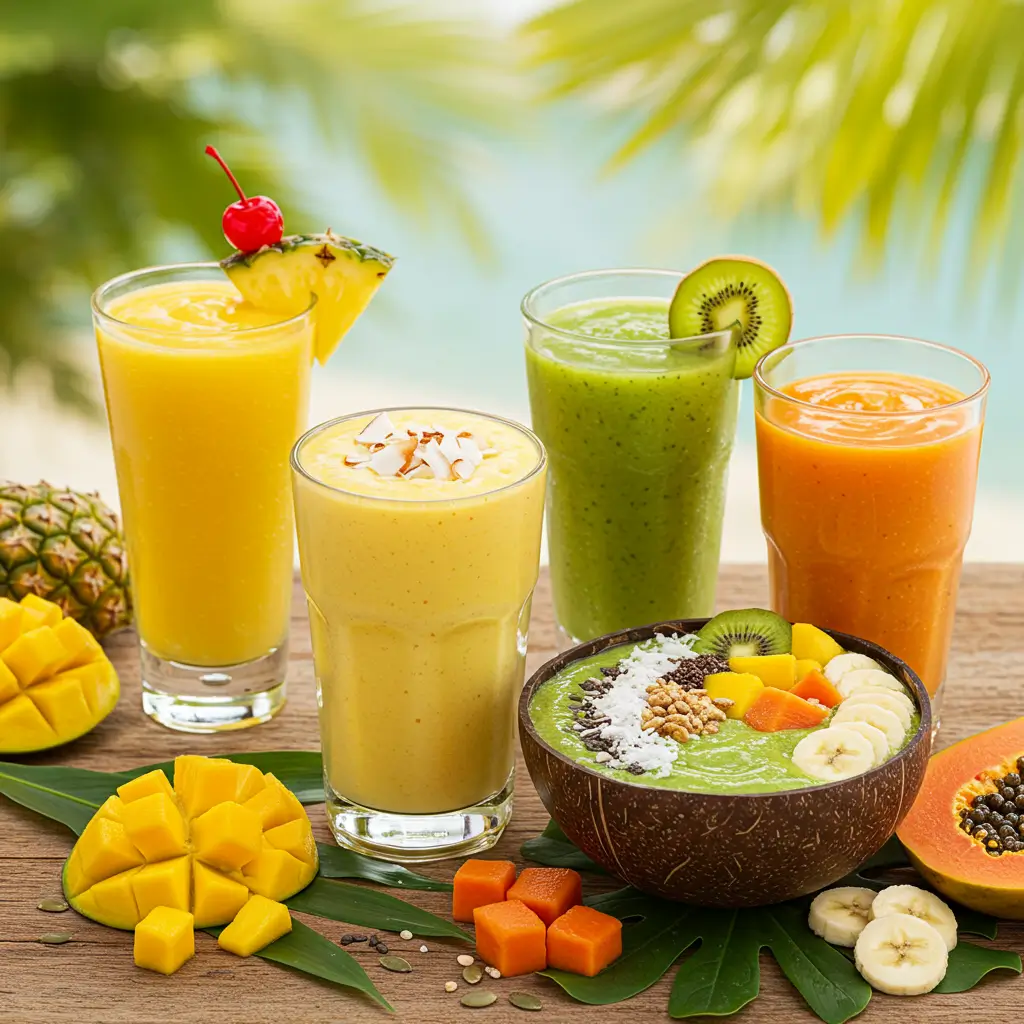
Best Liquid Bases for Tropical Smoothies
The liquid you choose impacts both the flavor profile and nutritional content:
- Coconut Water: Provides natural electrolytes and a light tropical taste without adding significant calories or fat. Perfect for more refreshing, lighter smoothies.
- Coconut Milk: Creates a richer, creamier smoothie with authentic tropical flavor. The full-fat version makes an indulgent treat, while light coconut milk offers a compromise between creaminess and calorie content.
- Pineapple Juice: Intensifies the tropical flavor profile but adds natural sugars. Use sparingly and preferably freshly squeezed for the best flavor and nutrition.
- Almond Milk: Offers a neutral base that lets tropical fruits shine while keeping calories lower. Unsweetened vanilla almond milk adds a subtle complementary flavor without extra sugar.
Nutritional Boosters and Flavor Enhancers
Elevate your tropical smoothie with these powerful additions:
- Chia Seeds: Add omega-3 fatty acids and fiber without altering the tropical flavor. Pre-soak them for 10 minutes if you don’t want the tapioca-like texture they create in liquids.
- Greek Yogurt: Increases protein content while adding creaminess. Use vanilla or coconut-flavored varieties for complementary flavor profiles.
- Ginger: Provides a subtle heat that enhances tropical flavors while offering anti-inflammatory benefits. Fresh ginger provides the brightest flavor—freeze and grate it for easy addition to smoothies.
- Lime or Lemon Juice: A small splash brightens all the flavors and adds vitamin C. Always add citrus juice at the end of blending to preserve the maximum vitamin content.
5 Classic Tropical Smoothie Recipes You Need to Try
Now that we understand the building blocks, let’s explore five perfectly balanced tropical smoothie recipes that consistently deliver amazing results. Each recipe makes approximately 16 ounces (one large or two small servings).
1. The Classic Tropical Paradise Smoothie
This smoothie captures the essence of tropical flavors with the perfect balance of sweet and tangy notes.
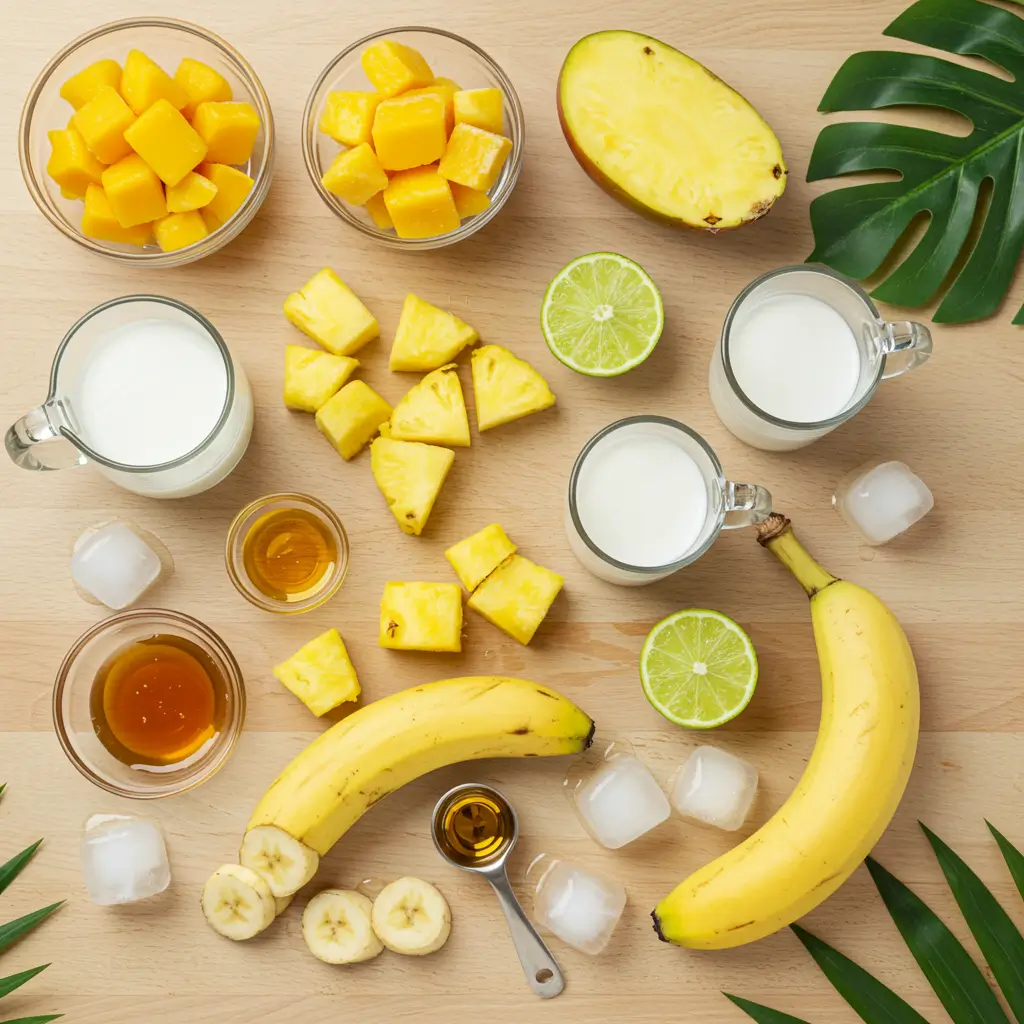
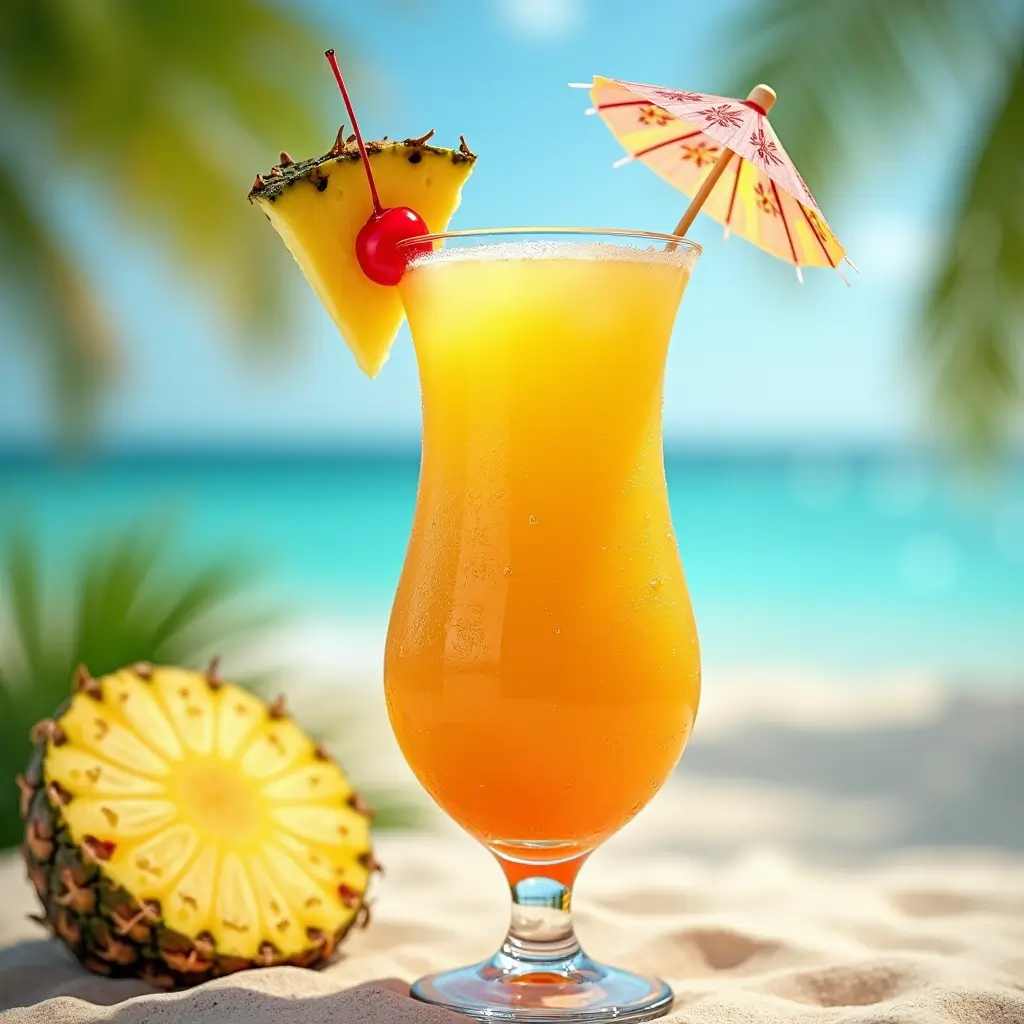
Ingredients:
- 1 cup frozen mango chunks
- 1/2 cup fresh pineapple pieces
- 1/2 ripe banana
- 1/4 cup coconut milk
- 1/4 cup coconut water
- 1 tablespoon honey (optional)
- 1/2 lime, juiced
- Ice cubes (optional)
Instructions:
- Add all ingredients except lime juice to your blender.
- Blend on high until smooth and creamy (approximately 45-60 seconds).
- Add lime juice and pulse briefly to incorporate.
- Pour into glasses and garnish with a pineapple wedge or lime slice if desired.
Nutritional boost: Add 1 tablespoon of chia seeds for omega-3 fatty acids and extra fiber.
2. Creamy Coconut-Mango Protein Smoothie
Perfect for post-workout recovery or a satisfying breakfast, this protein-rich tropical blend keeps you full while delivering island flavors.
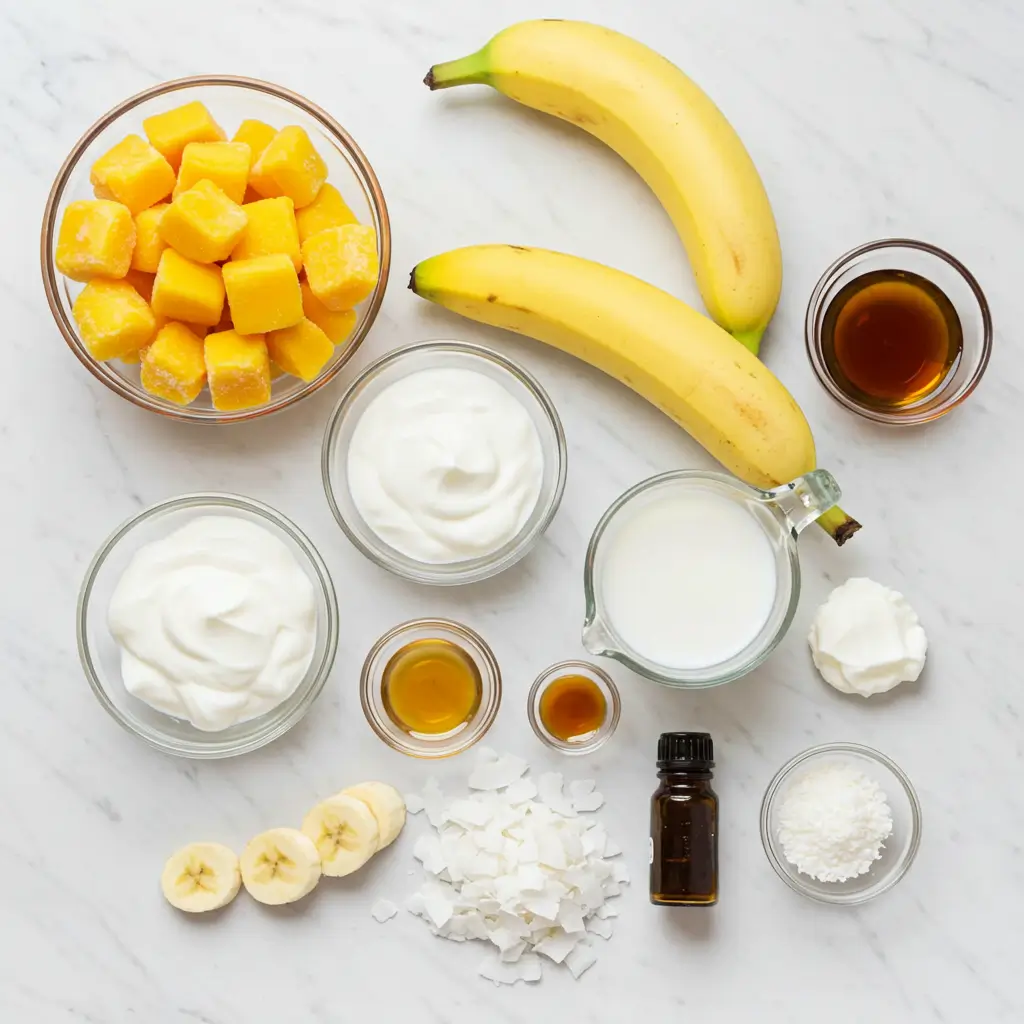
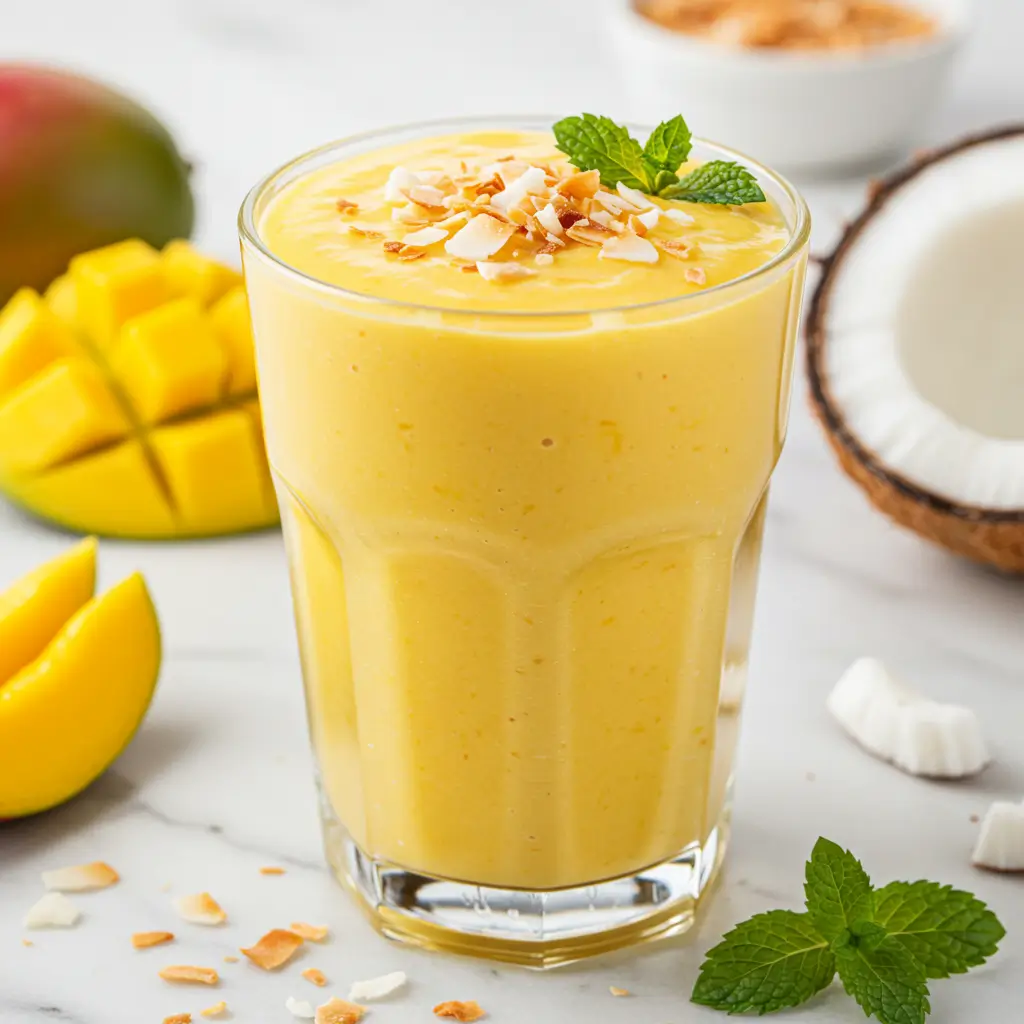
Ingredients:
- 1 cup frozen mango chunks
- 1/2 ripe banana
- 1/3 cup Greek yogurt (vanilla or plain)
- 1/2 cup coconut milk
- 1 tablespoon honey or maple syrup
- 1/4 teaspoon vanilla extract
- 1 tablespoon unsweetened coconut flakes, plus more for garnish
Instructions:
- Combine all ingredients in your blender.
- Blend on high until smooth and creamy (approximately 45-60 seconds).
- Pour into glasses and top with additional coconut flakes.
Nutritional boost: Add 1 scoop of vanilla protein powder to increase protein content by about 20 grams.
3. Tropical Green Energizer Smoothie
Don’t let the green color fool you—this nutrient-dense smoothie tastes like the tropics while sneaking in healthy greens.
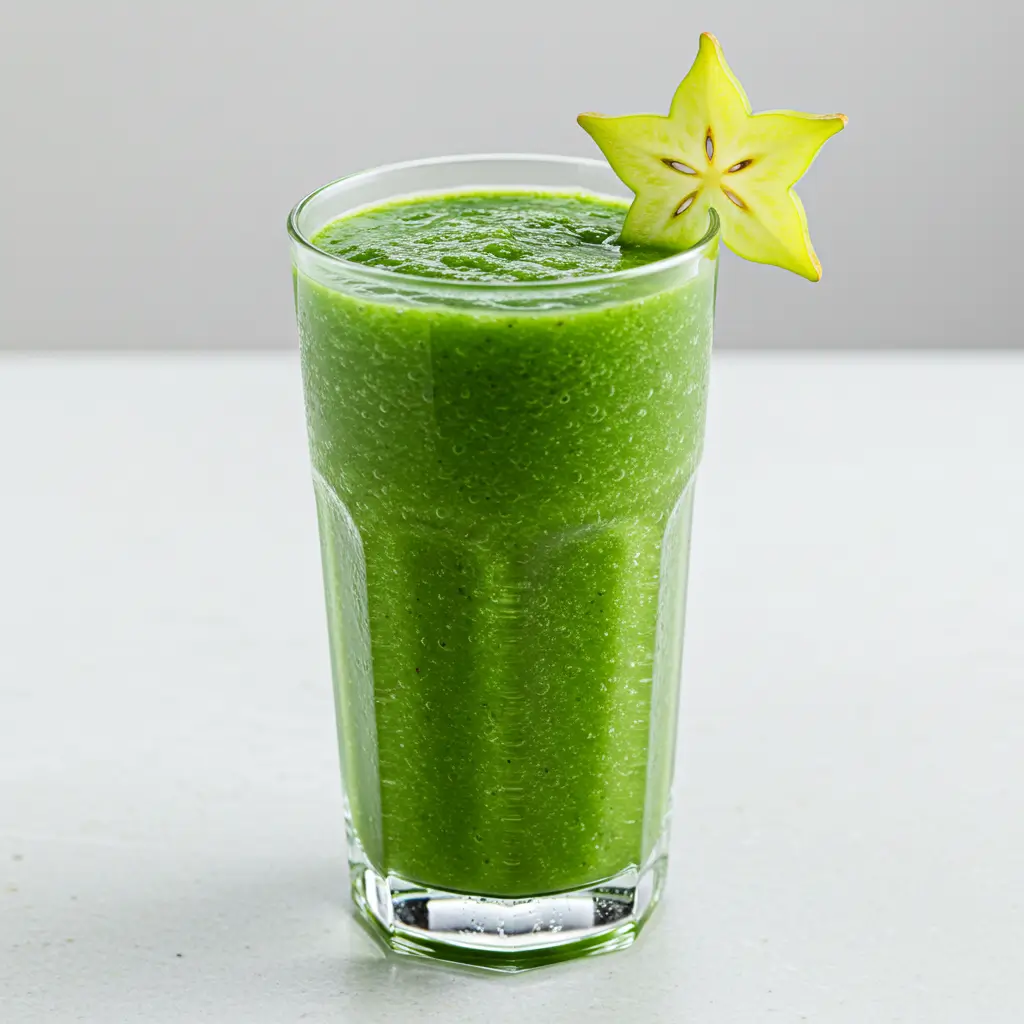
Ingredients:
- 1 cup fresh pineapple chunks
- 1/2 ripe banana
- 1 cup baby spinach (packed)
- 1/2 small avocado
- 1/4 cup coconut water
- 1/4 cup orange juice
- Small handful of mint leaves (optional)
- 1/2 lime, juiced
Instructions:
- Add all ingredients to your blender.
- Start blending on low speed, then gradually increase to high until perfectly smooth.
- Add additional coconut water if needed to reach desired consistency.
- Serve immediately to preserve the vibrant green color.
Nutritional boost: Add 1 teaspoon of spirulina for additional minerals and nutrients.
4. Papaya-Pineapple Digestive Smoothie
This smoothie combines fruits rich in digestive enzymes for a gut-friendly tropical treat.
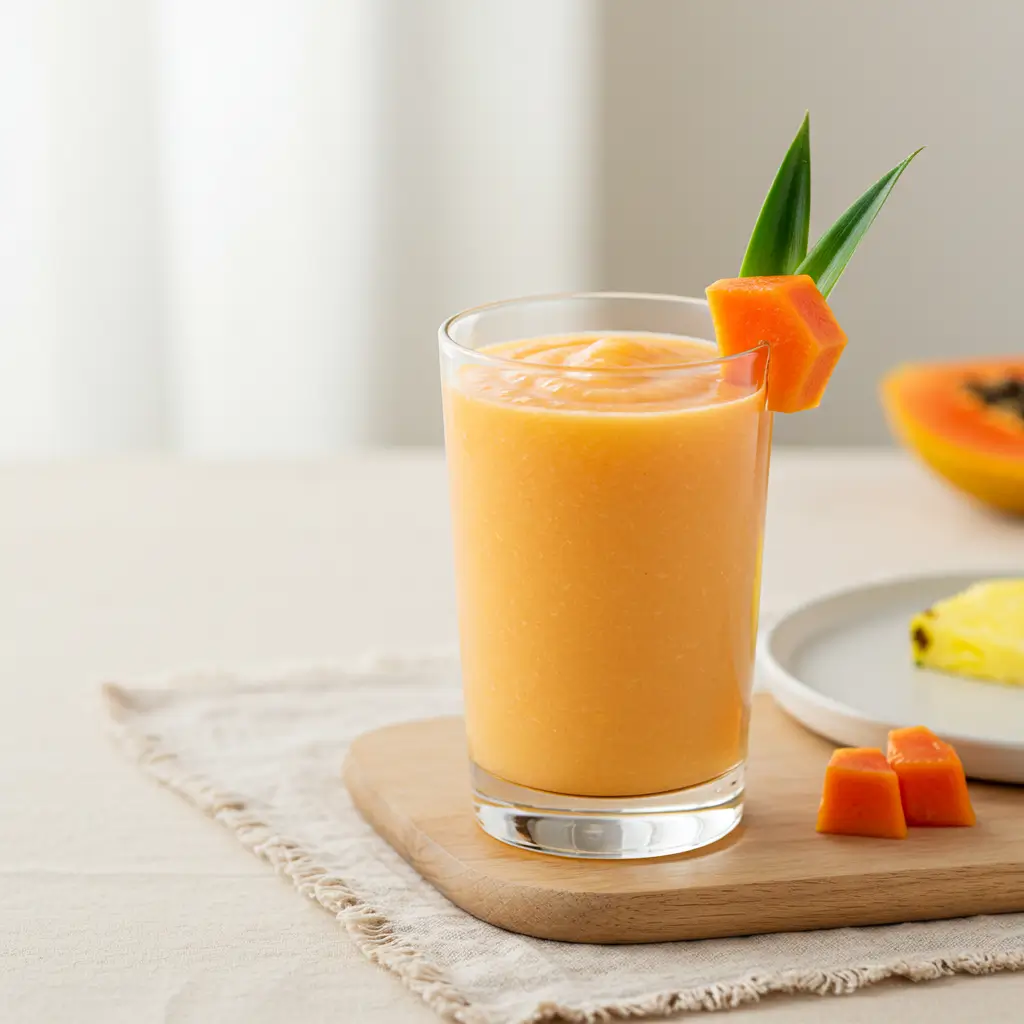
Ingredients:
- 1 cup ripe papaya chunks
- 1/2 cup pineapple pieces
- 1/2 inch fresh ginger, peeled
- 1/2 cup coconut water
- 1/4 cup Greek yogurt
- 1 teaspoon honey (optional)
- Small squeeze of lime juice
- Ice cubes as needed
Instructions:
- Add all ingredients to your blender.
- Blend until completely smooth (about 60 seconds).
- Add ice cubes for a thicker consistency if desired.
- Serve immediately or chill for up to 1 hour.
Nutritional boost: Add 1 tablespoon of ground flaxseed for additional fiber and omega-3 fatty acids.
5. Tropical Breakfast Smoothie Bowl
When you want to eat your tropical smoothie with a spoon and add delicious toppings:
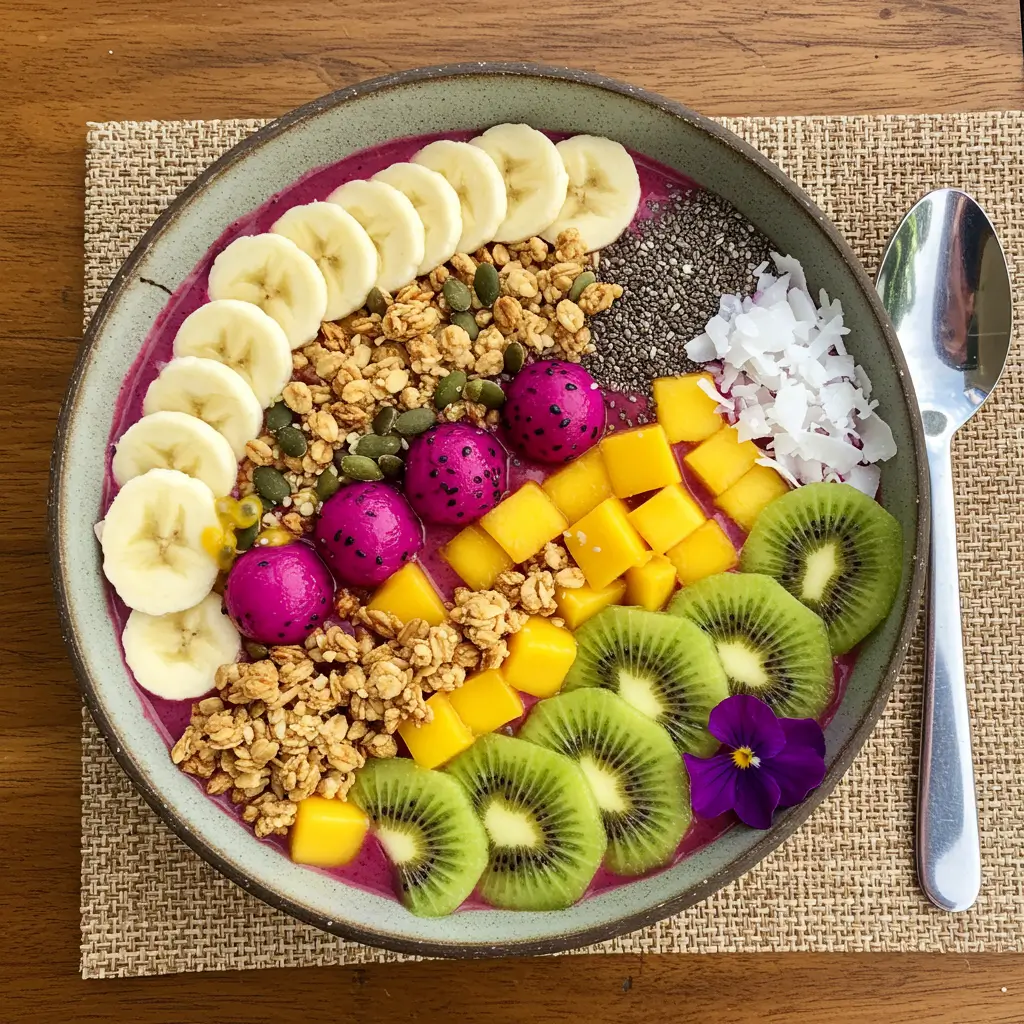
Ingredients:
- 1 frozen banana
- 1/2 cup frozen mango chunks
- 1/2 cup frozen pineapple pieces
- 1/4 cup coconut milk (thick part from the can)
- 1/4 cup Greek yogurt
- 1 tablespoon honey or maple syrup
For topping:
- Fresh kiwi slices
- Diced mango
- Coconut flakes
- Granola
- Chia seeds
Instructions:
- Blend all smoothie ingredients until thick and creamy, using minimal liquid to maintain a spoonable consistency.
- Pour into a bowl.
- Arrange toppings in sections across the surface.
- Serve immediately before it melts.
Pro tip: Freeze your serving bowl for 10 minutes before adding your smoothie to keep it thick longer.
Advanced Tips for Tropical Smoothie Perfection
Moving beyond basic recipes, these professional techniques will elevate your tropical smoothie game to resort-quality standards. Small adjustments in technique and ingredients make a significant difference in the final result.
Mastering Texture and Consistency
The perfect tropical smoothie should be smooth, creamy, and free of ice chunks or fibrous bits:
- Blending Order Matters: Always add liquids first, followed by soft fruits, then frozen ingredients and ice. This creates a vortex that pulls everything toward the blades for even blending.
- The 30-10-60 Method: Blend for 30 seconds, stop and scrape the sides, then blend again for 10 seconds on low and 60 seconds on high for perfectly incorporated ingredients without overheating.
- Temperature Control: For the smoothest texture, ensure at least one ingredient is frozen. Pre-freezing ripe banana slices or mango chunks on a baking sheet before transferring to storage bags prevents clumping and allows for easier portioning.
Balancing Flavors Like a Professional
Creating a balanced flavor profile requires understanding how different tastes interact:
- The Sweetness Scale: Tropical fruits vary dramatically in natural sugar content. Banana and mango provide natural sweetness, while pineapple and passion fruit contribute both sweetness and acidity. Taste your smoothie before adding sweeteners—you may need less than you think.
- Acid Brightening: A few drops of lime or lemon juice added at the end of blending acts as a flavor enhancer that makes all other ingredients taste more vibrant without making the smoothie taste citrusy.
- Salt Strategy: A tiny pinch (less than 1/8 teaspoon) of salt can dramatically enhance sweetness perception without adding sodium flavor. This professional trick reduces the need for added sweeteners.
Storage Solutions for Make-Ahead Preparation
Prepare components in advance for quick tropical smoothies anytime:
- Smoothie Freezer Packs: Portion all solid ingredients (except dairy) into individual freezer bags for grab-and-blend convenience. Include herbs and spices but leave liquids to add fresh.
- Freezing Techniques: Flash-freeze fresh tropical fruits on baking sheets before transferring to storage containers to prevent clumping. Label with dates—most fruits maintain optimal quality for up to 3 months.
- Preservation Methods: To extend the life of blended smoothies, fill containers to the very top (minimizing air exposure) and add a squeeze of lemon juice. Consume within 24 hours for best taste and nutrient content.
Tropical Smoothie Variations for Special Dietary Needs
Everyone deserves to enjoy tropical smoothies regardless of dietary restrictions. These adaptations ensure delicious results while accommodating specific needs.
Dairy-Free Tropical Smoothie Options
Create creamy, indulgent smoothies without any dairy products:
- Coconut Cream Alternative: Replace Greek yogurt with coconut cream (the solid part that rises to the top of coconut milk cans) for rich texture without dairy. Refrigerate the can overnight for easier separation.
- Avocado Base: Half an avocado provides creaminess similar to yogurt while adding healthy fats and making the smoothie more satiating. The mild flavor disappears behind tropical fruits.
- Silken Tofu Option: For a protein-rich dairy alternative, use 1/4 cup of silken tofu. Its neutral flavor disappears completely while adding protein and creating a milkshake-like consistency.
Lower-Sugar Tropical Smoothie Recipes
Enjoy tropical flavors without blood sugar spikes:
- Strategic Fruit Pairing: Combine higher-sugar fruits like mango or banana with lower-sugar options like papaya or passion fruit to maintain tropical flavor with fewer carbohydrates.
- Citrus Enhancement: Increase the proportion of lime or lemon juice, which adds minimal sugar while boosting tropical flavor. A tablespoon of unsweetened coconut flakes can also enhance tropical taste without adding significant carbohydrates.
- Natural Sweeteners: Replace honey or agave with monk fruit extract or a small amount of stevia. Start with less than you think you need—these alternatives are much sweeter than traditional sweeteners.
High-Protein Tropical Options
Transform tropical smoothies into complete nutritional meals:
- Seed Power: Blend in 2 tablespoons of hemp seeds for 6 grams of complete protein that doesn’t alter the tropical flavor profile.
- White Bean Secret: Add 1/4 cup of rinsed, drained white beans for a protein boost without changing the smoothie’s color or significantly affecting taste. The tropical flavors completely mask the bean flavor.
- Strategic Protein Powder Selection: Choose unflavored or vanilla protein powder to maintain the authentic tropical taste. Plant-based options like pea protein work well, but avoid those with strong flavors that might compete with the tropical fruits.
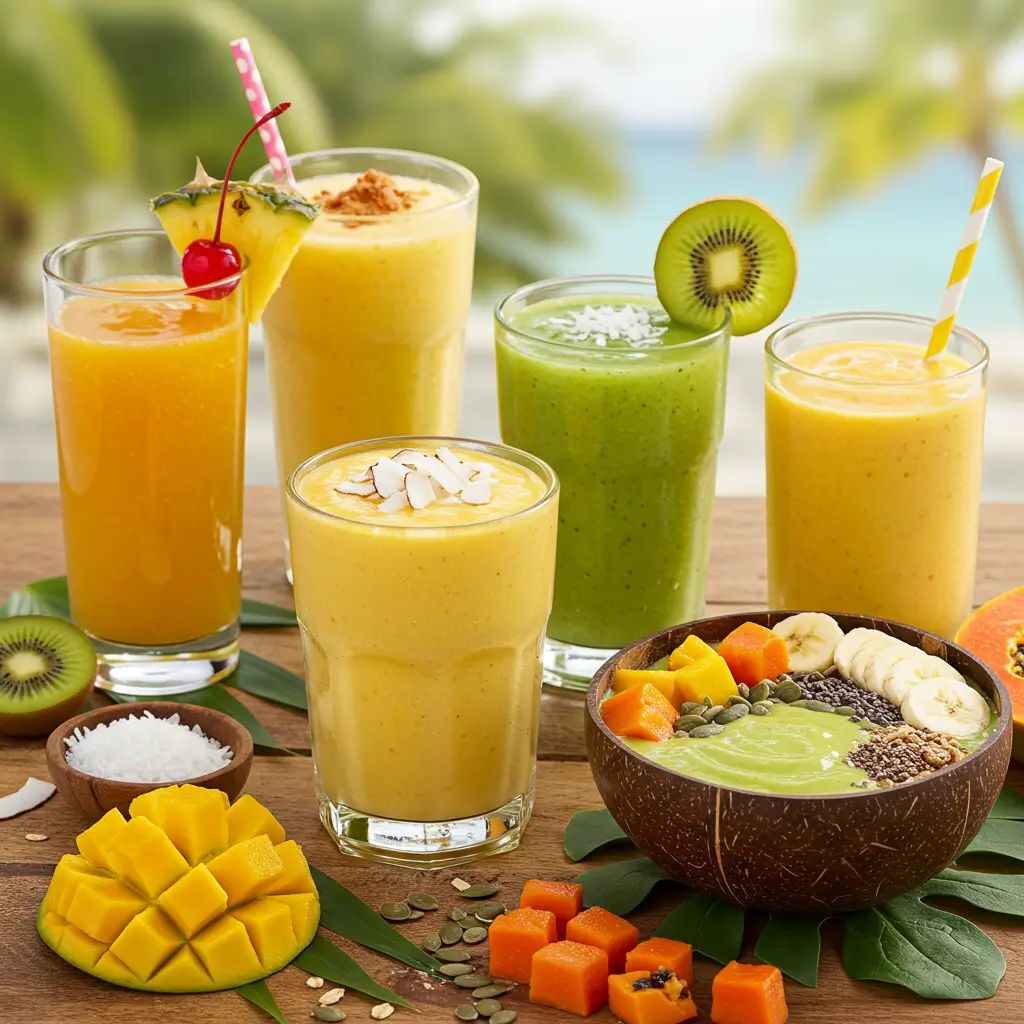
| Dietary Need | Best Fruit Base | Recommended Liquid | Top Protein Source | Sweetener Option |
|---|---|---|---|---|
| Dairy-Free | Mango & Banana | Coconut Milk | Hemp Seeds | Maple Syrup |
| Low-Sugar | Papaya & Passion Fruit | Almond Milk | Greek Yogurt | Monk Fruit Extract |
| High-Protein | Pineapple & Banana | Cow’s Milk | Whey Protein | Honey |
| Vegan | Mango & Pineapple | Oat Milk | Silken Tofu | Date Syrup |
| Keto-Friendly | Small Amount of Berries | Coconut Cream | MCT Oil | Stevia |
Frequently Asked Questions About Tropical Smoothie Recipes
How can I make my tropical smoothie recipes thicker without adding banana?
Bananas are popular thickeners in tropical smoothie recipes, but you have several excellent alternatives. Frozen mango chunks work wonderfully as they have a naturally creamy texture when blended. Half an avocado adds remarkable creaminess and healthy fats without significantly changing the flavor profile. For additional thickness, try adding 2-3 tablespoons of coconut yogurt, which enhances the tropical flavor while adding body. Finally, chia seeds (about 1 tablespoon) will naturally thicken your tropical smoothie if you let the mixture sit for 5-10 minutes before drinking.
What are the best tropical fruits to freeze for smoothies?
The best tropical fruits for freezing are those that maintain their flavor and texture after thawing. Mango tops the list as it freezes exceptionally well and actually becomes creamier when blended from frozen. Pineapple chunks freeze beautifully and add wonderful texture to tropical smoothie recipes. Banana slices are tropical smoothie staples that freeze perfectly—just peel and slice them before freezing on a baking sheet. Papaya maintains its gentle sweetness when frozen but should have seeds removed first. For best results, flash-freeze these tropical fruits in a single layer before transferring to freezer bags to prevent clumping.
Can I prepare tropical smoothie recipes in advance?
Yes, you can prepare tropical smoothie recipes in advance using two effective methods. First, you can create smoothie freezer packs by portioning all solid ingredients into individual bags and freezing them. When ready, simply add your liquid base and blend. Alternatively, you can blend complete tropical smoothies and store them in airtight containers for up to 24 hours in the refrigerator. Fill containers completely to minimize air exposure and add a teaspoon of lemon juice to preserve color and freshness. The texture may change slightly upon storage, so give stored tropical smoothies a quick shake or brief re-blend before enjoying.
Conclusion: Bringing the Tropics into Your Daily Routine
Tropical smoothie recipes offer more than just delicious refreshment—they provide a daily dose of nutrition wrapped in the flavors of paradise. By mastering these versatile blends, you’ve gained access to quick meals, nutritious snacks, and mood-lifting treats that can transform your everyday routine.
The beauty of tropical smoothies lies in their adaptability. Once you understand the basic principles and ingredient interactions, you can confidently experiment with whatever tropical fruits are in season or available in your freezer. These nutrient-dense beverages can serve as quick breakfasts during busy mornings, replenishing post-workout refreshments, or delightful afternoon pick-me-ups.
Remember that the perfect tropical smoothie reflects your personal taste preferences and nutritional needs. Don’t be afraid to adjust ratios, swap ingredients, or add your own special touches. With practice, you’ll develop an intuitive sense of what combinations create that ideal balance of flavor, nutrition, and tropical escape.
Why not bring a daily moment of paradise into your life? Choose one of these tropical smoothie recipes to try tomorrow morning, and notice how it brightens your day with flavor and nourishment. Your blender is ready—your tropical transformation awaits!
Ready to blend your way to paradise? Which tropical smoothie recipe will you try first? Share your creations or questions in the comments below!
Are You Try This Recipe ?
There are no reviews yet. Be the first one to write one.

